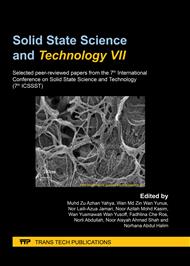[1]
B. Liu, H. Gu, Q. Chen, Preparation of nanosized Mo powder by microwave plasma chemical vapor deposition method, Mater. Chem. Phys. 59 (3) (1999) 204–209.
DOI: 10.1016/s0254-0584(99)00007-3
Google Scholar
[2]
M. Saghafi, A. Ataie, S. Heshmati-Manesh, Effects of mechanical activation of MoO3/C powder mixture in the processing of nano-crystalline molybdenum, Int. J. Refract. Met. Hard Mater., 29 (4) (2011) 419–423.
DOI: 10.1016/j.ijrmhm.2010.12.012
Google Scholar
[3]
A.D. Kirshenbaum, A.J. Beardell, Thermal analysis of the reaction of molybdenum trioxide with various metals, Thermochim. Acta 4 (1972) 239–248.
DOI: 10.1016/0040-6031(72)87008-4
Google Scholar
[4]
M. Saghafi, S. Heshmati-Manesh, A. Ataie, A.A. Khodadadi, Synthesis of nanocrystalline molybdenum by hydrogen reduction of mechanically activated MoO3, Int. J. Refract. Met. Hard Mater. 30 (2012) 128–132.
DOI: 10.1016/j.ijrmhm.2011.07.014
Google Scholar
[5]
J. Ku, J. Oh, H. Kwon, J. Lim, Hi-temperature hydrogen-reduction process for the preparation of low-oxygen Mo powder from MoO3, Int. J. Hydrogen Energy 42 (2017) 2139–2143.
DOI: 10.1016/j.ijhydene.2016.09.004
Google Scholar
[6]
S. Chaudhury, S.K. Mukerjee, V.N. Vaidya, V. Venugopal, Kinetics and mechanism of carbothermic reduction of MoO3 to Mo2C, J. Alloys Compd. 261 (1997) 105–113.
DOI: 10.1016/s0925-8388(97)00212-0
Google Scholar
[7]
J. Dang, G.H. Zhang, K.C. Chou, R.G. Reddy, Y. He, Y. Sun, Kinetics and mechanism of hydrogen reduction of MoO3 to MoO2, Int. J. Refract. Met. Hard Mater. 41 (2013) 216–223.
DOI: 10.1016/j.ijrmhm.2013.04.002
Google Scholar
[8]
J. Wang, Z. Ren, W. Liu, F. Gao, M. Zhou, Effects of RE2O3 doping on the reduction behavior of molybdenum oxide and properties of molybdenum powder, Int. J. Refract. Met. Hard Mater. 27 (2009) 155–158.
DOI: 10.1016/j.ijrmhm.2008.06.003
Google Scholar
[9]
A. Samsuri, T.S. Tengku Saharuddin, F. Salleh, R. Othaman, M.W. Mohamed Hisham, M.A. Yarmo, Temperature programmed reduction and x-ray diffractometry studies of MoO3 reduction by different concentration of carbon monoxide, Malaysian J. Anal. Sci. 20 (2) (2016) 382–387.
DOI: 10.17576/mjas-2016-2002-22
Google Scholar
[10]
I.R. Leith, M.G. Howden, Temperature-programmedreduction of mixed iron-manganese oxide catalysts in hydrogen and carbon monoxide, Appl. Catal. 37 (1988) 75–92.
DOI: 10.1016/s0166-9834(00)80752-6
Google Scholar
[11]
H. Mohammadzadeh, H. Rezaie, H. Samim, M. Barati, H. Razavizadeh, Reduction and carburization behavior of NiO – WO3 mixtures by carbon monoxide, Thermochim. Acta 590 (2014) 210–218.
DOI: 10.1016/j.tca.2014.07.003
Google Scholar
[12]
G. Sun, G. Zhang, X. Ji, J. Liu, H. Zhang, K. Chou, Size-controlled synthesis of nano Mo powders via reduction of commercial MoO3 with carbon black and hydrogen, Int. J. Refract. Metals Hard Mater. 80 (2019) 11–22.
DOI: 10.1016/j.ijrmhm.2018.12.019
Google Scholar
[13]
L. Liao, H.X. Mai, Q. Yuan, H.B. Lu, J.C. Li, C. Liu, C.H. Yan, Z.X. Shen, T. Yu, Single CeO2 nanowire gas sensor supported with Pt nanocrystals: Gas sensitivity, surface bond states, and chemical mechanism, J. Phys. Chem. C 112 (24) 2008 9061–9065.
DOI: 10.1021/jp7117778
Google Scholar
[14]
L. Koao, H.C. Swart, F.B. Dejene, Effects of aluminum co-doping on photoluminescence properties of Ce3+-doped SiO2 glasses, J. Rare Earths 28 (2010) 206–210.
DOI: 10.1016/s1002-0721(10)60368-7
Google Scholar
[15]
L. Jiang, H. Zhu, R. Razzaq, M. Zhu, C. Li, Z. Li, Effect of zirconium addition on the structure and properties of CuO/CeO2 catalysts for high-temperature water-gas shift in an IGCC system, Int. J. Hydrogen Energy 37(21) (2012) 15914–15924.
DOI: 10.1016/j.ijhydene.2012.08.055
Google Scholar
[16]
E. Lalik, Kinetic analysis of reduction of MoO3 to MoO2, Catal. Today 169 (2011) 85–92.
DOI: 10.1016/j.cattod.2010.09.013
Google Scholar
[17]
N. Dzakaria, M.N.A. Tahari, F. Salleh, A. Samsuri, M.A.H. Azizi, T.S.T. Saharuddin, M.R. Yusop, W.N.R.W. Isahak, M.W.M. Hisham, M.A. Yarmo, Chemical reduction behavior of zirconia doped to nickel at different temperature in carbon monoxide atmosphere, Indones. J. Chem. 20 (1) (2020) 105–112.
DOI: 10.22146/ijc.40891
Google Scholar
[18]
A. Samsuri, T.S. Tengku Saharuddin, F. Salleh, R. Othaman, M.W. Mohamed Hisham and M.A. Yarmo, Study on the reduction behavior of molybdenum oxide (MoO3) in carbon monoxide (CO) atmosphere, Mater. Sci. Forum 840 (2016) 299–304.
DOI: 10.4028/www.scientific.net/msf.840.299
Google Scholar
[19]
F. Salleh, T.S. Tengku Saharuddin, A. Samsuri, R. Othaman and M.A. Yarmo, Effect of zirconia and nickel doping on the reduction behavior of tungsten oxide in carbon monoxide atmosphere, Int. J. Chem. Eng. Appl. 6 (2015) 389–394.
DOI: 10.7763/ijcea.2015.v6.516
Google Scholar
[20]
C. Wang, L. Yin, L. Zhang, D. Xiang, and R. Gao, Metal oxide gas sensors: Sensitivity and influencing factors, Sensors 10 (3) (2010) 2088–2106.
DOI: 10.3390/s100302088
Google Scholar


